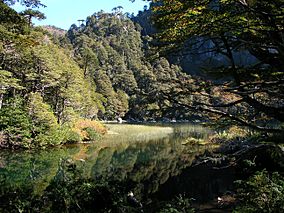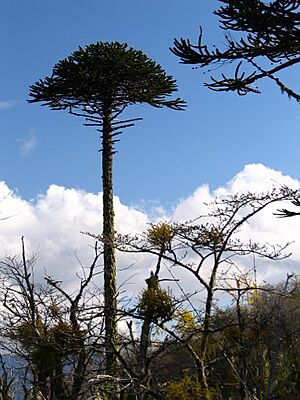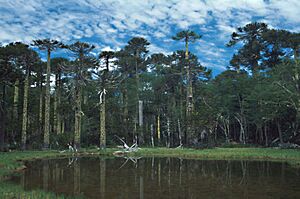Huerquehue National Park facts for kids
Quick facts for kids Huerquehue National Park |
|
|---|---|
|
IUCN Category II (National Park)
|
|

a view along the Three Lakes Hiking Trail.
|
|
| Location | La Araucanía Region, Chile |
| Nearest city | Pucón |
| Area | 125 km² |
| Established | 1967 |
| Governing body | Corporación Nacional Forestal |
Huerquehue National Park (pronounced wehr-KEH-weh) is a special natural area in southern Chile. It's found in the foothills of the Andes mountains, within a beautiful type of forest called the Valdivian temperate rainforest.
The park covers about 125 square kilometers (that's 12,500 hectares) of mountains. Its height ranges from 720 to 2,000 meters above sea level. It's located east of Caburgua Lake, about 145 kilometers southeast of Temuco and 33 kilometers east of Pucón.
Huerquehue National Park was officially created on June 9, 1967, to protect this amazing place. However, its history goes back to 1912 with the creation of "Benjamín Vicuña Mackenna Park," which was much larger. Today, that original land is split into several different parks and reserves.
The name "Huerquehue" comes from the Mapudungun language, spoken by the Mapuche people. It means "the messenger’s place." One of the most famous things about Huerquehue National Park is its very old Araucaria forests. These trees are also known as "monkey puzzle" trees. They stand tall around the park's clear lakes and lagoons, like Tinquilco Lake, which is in the lower part of the park.
Contents
Visiting Huerquehue National Park
The main entrance to the park is about 2 kilometers from Tinquilco Lake. You can find it at kilometer 20 on the road to Caburga Lake. The park ranger’s cabin is right at this entrance. Huerquehue National Park is open to visitors all year round.
Weather in the Park
The park has two main types of weather during the year. Summers are warm and have less than four dry months. Winters are cold and icy because of the high mountains. The wettest months are from May to September. The park gets a lot of rain, about 2,045 millimeters (80 inches) each year.
Waterways and Lakes
Huerquehue National Park is home to many rivers and lakes. The biggest rivers are the Renahue Blanco and Quinchol. There are also many smaller streams that flow all the time.
The park has about 20 bodies of water. Most of these are small, less than 7.5 hectares. The most important lakes are Lake (27.5 hectares) and Verde (32.5 hectares). There are also ponds like Los Patos, Huerquehue, Escondida, Seca, Clara, Las Avutardas, Angelina, and Los Cóndores. All these water sources flow into the Toltén River.

Plants of Huerquehue
The park is part of the Valdivian temperate rainforest. More specifically, it's an Andean-Patagonian forest, found in the Araucanía Mountain range. You'll find different types of forests here, including those with deciduous trees that lose their leaves.
The most special tree in Huerquehue National Park is the Araucaria araucana. These amazing trees are considered a vulnerable species, meaning they need protection to survive.
Animals of Huerquehue
Huerquehue National Park protects many different animals. Some of these species are rare or endangered, so the park helps keep them safe.
Mammals
- Kodkod or Güiña (Leopardus guigna): This small wild cat is endangered.
- Pudú: This is the world's smallest deer and is considered vulnerable.
- Geoxus or Long-clawed mole mouse (Geoxus valdivianus): This mouse is rare.
- Culpeo or Andean Fox (Lycalopex culpaeus): This fox looks like a red fox and is the second largest wild dog in South America. It is not currently at risk.
Birds
- Peregrine falcon: This fast bird is endangered.
- Chilean pigeon: This pigeon is vulnerable.
- Magellanic woodpecker: This large woodpecker is vulnerable.
- Condor: This huge bird is rare.
- Black-necked swan: This beautiful swan is not currently at risk.
- Slender-billed parakeet or Choroy Parakeet: This colorful parakeet is not currently at risk.
Amphibians
- Darwin's frog or southern Darwin’s frog: This unique frog is vulnerable.
Images for kids
See also
 In Spanish: Parque nacional Huerquehue para niños
In Spanish: Parque nacional Huerquehue para niños







